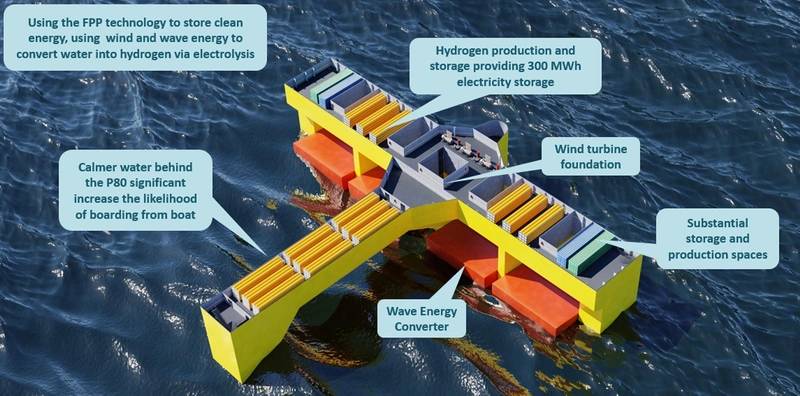Feature
Floating Offshore Wind
A Floating Power Trio: Wind, Waves and H₂0
Floating offshore wind is now firmly on the radar as a global investment opportunity, with plenty of deeper waters ripe for development. But it’s not just it’s ability to access deeper water resources that many are eying this technology. It’s ability to provide a local power source to, for example, offshore oil and gas facilities or remote islands, is also making it attractive, especially when combined with hydrogen production.
By Elaine Maslin
Floating Power Plant’s half scale P37 prototype, which has undergone offshore testing, including supplying wave and wind powered electricity to the grid.
Image from Floating Power Plant.Floating offshore wind is now firmly on the radar as a global investment opportunity, with plenty of deeper waters ripe for development. But it’s not just it’s ability to access deeper water resources that many are eying this technology. It’s ability to provide a local power source to, for example, offshore oil and gas facilities or remote islands, is also making it attractive, especially when combined with hydrogen production.
Danish firm Floating Power Plant has been exploring this idea. Formed in 2004, the company has been developing a floating offshore wind turbine that also houses wave energy converters. The idea caught recently the attention of Swedish energy firm Lundin, as a way to provide power to subsea oil and gas infrastructure, potentially even subsea water treatment and injection equipment, says Chris McConville, general manager at Floating Power Plant. Then TotalEnergies’ Denmark operations saw the concept and suggested integrating hydrogen production and fuel cells, to provide stable offshore power to other offshore facilities came up.
“At the time, we were looking at diesel generator bunkering,” McConville told RenewableUK’s Floating Offshore Wind conference in Aberdeen in September. “TotalEnergies helped come up with the alternative of using hydrogen.”

Floating Power Plant’s concept complete with hydrogen production and storage capability (turbines not shown).
A Modular Design
Floating Power Plant’s core design is based on a semisubmersible foundation, but one that’s more like a ship than other more truss-like designs and is moored using a disconnectable turret style catenary mooring that can weathervane, says McConville. Having a design more like a ship means it can be built using more traditional ship building methods and lends itself to modular assembly and fabrication and enables serial production, he says. It also allows for the integration of four WECs, adding 2-4 MW to whatever the size of the turbine (4-15 MW) is on the platform (this can be whatever is supplied). And it meant there was potential space to integrate hydrogen production and fuel cells.
A prototype, P37, has been tested offshore for a number of years. Now, to introduce hydrogen to the concept, Floating Power Plant has been working with TechnipFMC and its Deep Purple technology as part of the O/G Decarb project. Another deck was added to the floater design and the space that was created was given to TechnipFMC to use to work in the Deep Purple concept, comprising electrolysis, storage and fuel cells, says McConville. The result is what’s been called a Power-2-X solution, a platform able to house up to 300 MWh of electricity as hydrogen. The project also looked at sending any surplus hydrogen production to shore by blending it into the transmission system – also reducing the carbon intensity of that gas.
“TotalEnergies wanted consistent 5MW power,” says McConville. So a 12 MW turbine was suggested, with 2MW wave power. “When producing 5MW, that would go straight to the platform,” he says. “Sometimes it might be producing 12-14MW. Instead of wasting electricity, sea water would be turned into hydrogen and stored for later.” That would meet the demand the 5MW would need for 90% of the time, he says. “It makes a real difference to the way oil and gas can think about integrating technology like wind and wave energy. And it’s all done on the abatement activity cost to remove every tonne of CO2.”
For short life projects, of two years, that might not add up. But for 20-25-year projects, “it’s a different story”, he says. It also depends on what it’s being compared with. At a brownfield site, there’s either the cost of local fuel and CO₂ emissions trading scheme or tax costs, or to bring in power from shore and the cost of a cable. Furthermore, as floating offshore wind costs come down, the savings could be significant, he says. “When you add everything up, it doesn’t take long to get to something that works. The cost of fuel and CO2 tax is going up and you’re actually saving money using a renewable energy solution.”
Integrated hydrogen is not for all scenarios, however, he says, such as grid connected projects. “There are some possibilities to use hydrogen to transmit energy to shore, instead of power,” he says. “But the focus just now is oil and gas decarbonization and remote islands, which have some similarities and might have a weak grid. Hydrogen offers them some flexibility. Oil and gas want low risk and cannot accept zero power when the wind doesn’t blow. There’s a lot of potential in oil and gas decarbonization. We have five other projects in early discussion,” he says, “in the UK, Brazil and Norway.”
Floating Power Plant is now working with Orcadian Energy (formerly Pharis Energy and The Steam Oil Production Company before that) looking at its heavy oil Pilot field with Crondall Energy to provide a constant power supply. McConville says the firm is also looking at expanding the existing PLOCAN (The Oceanic Platform of the Canary Islands) project it’s involved in and integrating hydrogen on to it, which would make it a world first floating offshore wind facility with integrated hydrogen production. That’s being worked on under a memorandum of understanding with PLOCAN, with deployment potentially lined up for 2024.
Floating Power Plant’s half scale P37 prototype, which has undergone offshore testing, including supplying wave and wind powered electricity to the grid.